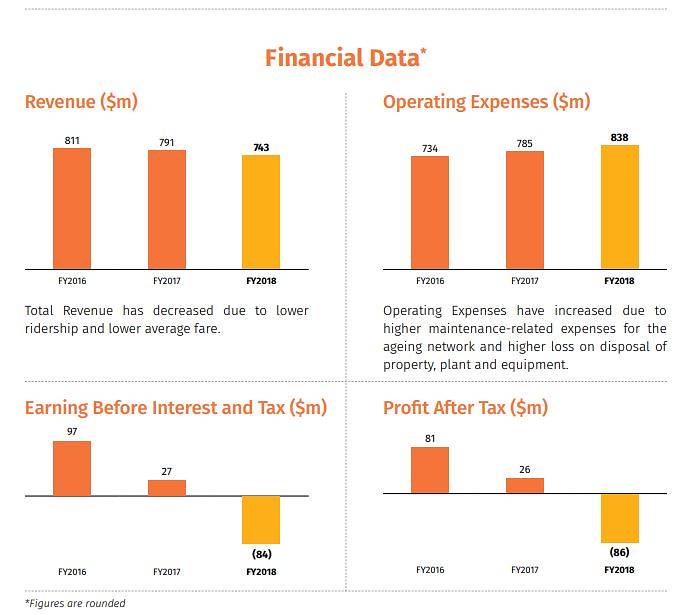SINGAPORE: Amid a fall in ridership and higher maintenance expenses, SMRT Trains posted an S$86 million after-tax loss for the 2018 financial year ending Mar 31.
The loss follows an after-tax profit of S$26 million for the previous financial year, according to an annual operations review report posted on its website on Sunday (Jul 1).
Revenue declined from S$791 million to S$743 million due to a fall in ridership and lower average fares, the company said. Ridership fell from 768 million to 753 million, with average weekday ridership at 2,258, down from 2,353 the previous year.
Operating expenses jumped from S$785 million to S$838 million. SMRT Trains said this was due to higher maintenance costs for the ageing rail network and higher loss on disposal of property, plant and equipment.

SMRT Trains’ financial figures for FY2018. (Source: SMRT Trains)
IMPROVED RELIABILITY ON 2 OF 3 RAIL LINES
SMRT Trains’ CEO Lee Ling Wee said in the report that the company “recognises that commuter satisfaction has declined in the last year”.
This is especially after the launch of the new signalling system in mid-2017 and two major disruptions late last year, such as the Bishan-Braddell tunnel flooding incident.
“Learning from the 7 October tunnel flooding episode, we have tightened work processes and supervisory checks across all levels in the organisation, and will use resources more effectively as we get our renewal and maintenance efforts firmly back on track in building infrastructure and facilities management,” Mr Lee said.
He also noted that reliability has improved on two out of three of SMRT’s rail lines.
Between April 2017 and March 2018, the Circle Line and East-West Line saw an improvement in their mean kilometres between failure (MKBF), which measures the number of kilometres clocked before a delay of more than five minutes.
The Circle Line’s average MBKF for the 12 months up to March was 665,000km, compared to 281,800km in the preceding 12 months, while the East-West Line’s MKBF rose from 151,400km to 171,000km.
However, the North-South Line’s MKBF fell from 180,400km to 97,000km. This was due to teething issues on the new signalling system, Mr Lee said.
SMRT Trains’ employee accident frequency rate for FY2018 was 1.44, compared to 1.14 in the previous financial year. However, SMRT Trains said that this was still lower than the logistics and transport industry average of 3.0.




